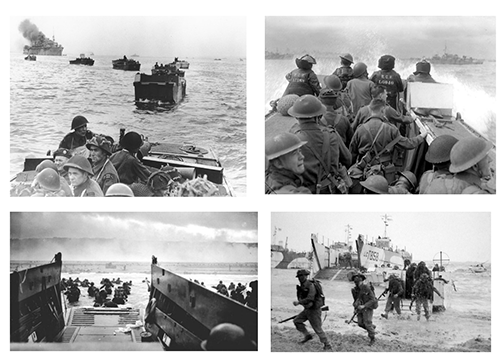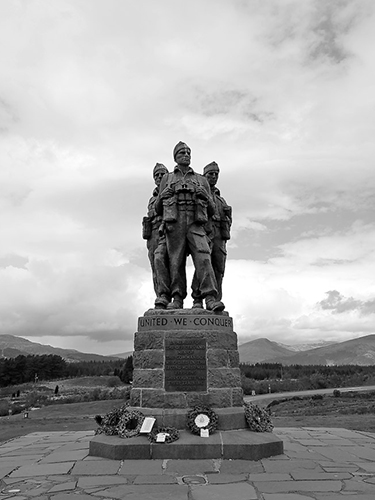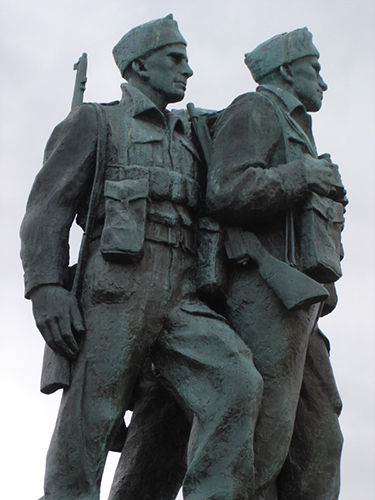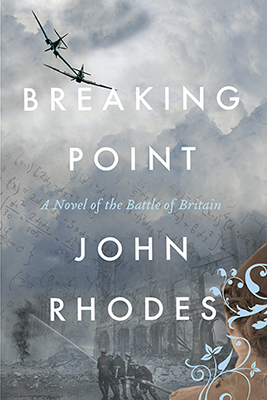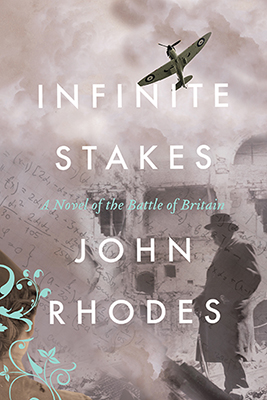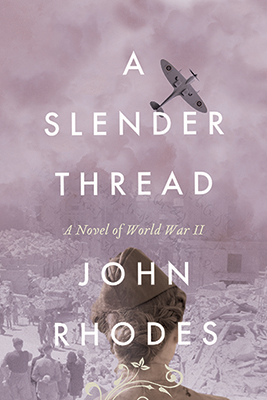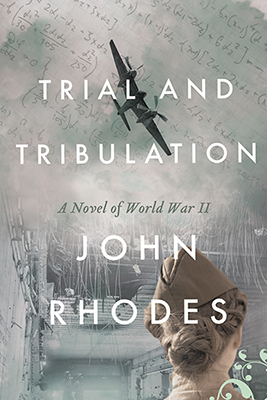On that cold, stormy morning in June, 80 years ago, tens of thousands of young men crossed the English Channel in thousands of small ships to Nazi-occupied France. The Normandy beaches—codenamed Omaha, Utah, Gold, Juno, and Sword, awaited them. Hitler’s Army Group B, dug in behind massive defensive fortifications and commanded by the brilliant Generalfeldmarschall Erwin Rommel, stood ready to repel them.
The Allied forces—British, Canadian, and American—had been trained and toughened for this ordeal, but nothing could quite prepare them for this, perhaps the most consequential clash of armies in the long and brutal history of warfare.
Some of the very first men in the leading boats had been trained as commandos in Scotland, where a memorial to those who did not return stands above the hard landscape.
My new book opens on the fateful morning.
LCA 1654
June 6th, 1944, 0645 Hrs
The skies were noticeably brighter and Shaux, peering over the bulwark, could see that LCA 1654 was just one in a line of LCAs that had been launched from the big freighter SS Empire Arquebus, lowered down the side dangling from steel cables and then dumped unceremoniously the last three feet into the lumpy waves. The coast of Normandy was an indistinct smudge ahead of them to the south. Off to the left he could see the cruiser HMS Scylla, the Eastern Task Force flagship, and beyond that he could see long muzzle flashes as an elderly cruiser fired her 6-inch guns at the coastal village of Ouistreham. Beyond Scylla there were many other flashes stabbing the gloom as a half-a-dozen more ships pounded the coastline to suppress German defensive fire.
Altogether, dozens of destroyers, cruisers, and battleships were battering this part of Hitler’s Atlantic Wall, his long chain of defensive gun batteries, beach obstructions, minefields, machine gun nests, pillboxes, anti-aircraft flak batteries, anti-tank devices, strongpoints, and endless miles of barbed wire. Eleanor had told him that Erwin Rommel, the Desert Fox, Germany’s best general, was in charge of the fortifications. Inland, waiting for any Allied troops that could penetrate the Wall and advance off the beaches, were tens of thousands of German troops with their thousands of artillery pieces and Panzer tanks.
Shaux glanced at his watch and saw it was 0645. Another three miles—perhaps thirty minutes—to the beach.
He sat back down against the bulwark and fumbled with his waterproof cigarette case. He lit two cigarettes with his prized American Zippo lighter—a gift from his friend Bob O’Neill, a USAAF B17 pilot—and handed one to Cranmer.
“Half-an-hour to the beach, Flight,” he said.
“Can’t ’ardly wait, sir,” Cranmer said.
Shaux drew on his cigarette. He didn’t like the sea. He’d almost drowned in it twice, once escaping Dunkirk back in 1940 and once in the Mediterranean in 1942, and he didn’t want to attempt a hat-trick. Yet here he was—voluntarily—in a small boat in rising seas sailing toward an enemy coastline. No, he thought, upon reflection it wasn’t ironic he was here: it seemed strangely inevitable, the logical result of a logical sequence of events.
Last year he’d been flying De Havilland Mosquitos. The last mission involved bombing a U-Boat pen in the far north of Norway. The attack had been successful in putting the pen out of service, but he’d lost every other aircraft in the squadron and landed with his navigator dead beside him. No one else in the history of the RAF had ever managed to lose an entire squadron in a single op, but the Air Ministry propaganda machine had smoothly reframed the mission from what Shaux considered a disaster into a triumph, with Shaux cast in the role of intrepid, invincible hero. An RAF photographer had instructed him to look not at the camera but off into the sky above the photographer’s right shoulder as he took Shaux’s photograph. The resulting image, as it appeared in several newspapers, left it up to the viewer to decide whether Shaux was searching the skies for enemy aircraft, or mournfully recalling his lost squadron, or contemplating eternity with appropriately heroic equanimity.
He’d been ‘rested’—RAF parlance for being taken out of active operational duties—and assigned to the loathsome job of touring factories and dockyards as an officially designated war hero: ‘and now, ladies and gentlemen, let’s welcome the man who bombed Hitler’s U-Boat pens … Johnnie Shaux!’ Then Eleanor had asked him a casual question about the best way to target tactical fighter sweeps against moving enemy armor, pinpoint attacks in a fast-moving battlespace. That had led to the notion of Air Ground Support Control, already successfully pioneered in the invasion of Italy, which had led to the notion that ground forces invading Normandy should have among them experienced RAF officers who could radio in Mustang and Typhoon aircraft to strafe enemy positions and vehicles, which had led—inevitably, with twenty-twenty hindsight—to Shaux sitting in a LCA chugging toward the coast of Normandy in one of the first waves of the great Allied assault, with Flight Sergeant Cranmer with his radio beside him.
When the concept of AGSC had been adopted Shaux had been attached temporarily to an RAF Servicing Commando unit—Shaux had previously had no idea that the RAF, like the Army and the Marines, had its own commandos—and sent to Achnacarry in the Scottish Highlands for commando training.
It had been an interesting experience. He and a contingent of other trainees had travelled by train to Spean Bridge railway station where they were met by Color Sergeant Johnston of the Royal Marines.
“These here rucksacks are Pattern 42 Bergens,” Johnston said. “Each Bergen contains your necessary clothing and supplies, your first aid kit and your rations, enough for forty-eight hours. These webbing straps are your 1937 Pattern Web Equipment that carry your M1911 side arm in its holster, your Fairbairn-Sykes fighting knife in its sheath, your water bottles, your grenades, and your ammunition pouches. Put the webbing straps on first, and then your Bergen.”
Shaux struggled his way into his webbing, festooned with canvas pouches containing absurdly heavy objects.
Johnston inspected him and shook his head.
“Posture, sir, posture! If you stand up straight—” he stepped behind Shaux and jerked his shoulders back, “—and keep your straps nice and snug, like this—” he tugged sharply on several straps, “—then you might look less like a Glasgow drunk on a Saturday night and more like a member of His Majesty’s fighting forces.”
“Sir,” he added. “Now that’s sorted, this here’s your Bergen.”
Just as the webbing and its pouches weighed down his chest the Bergen knapsack now weighed down his back. Perhaps it would balance his drunk-like posture.
“Now, all trainees will take a M28M1 Thompson gun from them racks there and form up on the road outside the station in columns of three.”
The trainees organized themselves into the semblance of a military platoon.
“Your Thompson guns are fully loaded and lightly triggered so you may want to check that the safety is on. They have a tendency to fire if dropped.”
Shaux stared at his gun as if it was a cobra coiled and ready to strike and gingerly felt for the safety catch just behind the trigger guard. It was in the back-facing ‘on’ position, thank God.
“Never, ever, handle a weapon without verifying it’s safe,” Johnstone said, as Shaux inwardly berated himself for such a stupid error. “You’re supposed to kill the enemy, not each other.”
It occurred to Shaux that Johnston had made sure everyone’s safety catch was on before they touched the weapons, but that didn’t detract from the sharpness of the lesson.
Johnston stood back and inspected the untidy column of trainees, shaking his head, perhaps in sorrow but more probably in pity.
“Achnacarry Castle is just eight miles up the road, just a nice walk to stretch your legs. Any trainee who fails to keep up will be RTU’d.”
It began to drizzle. Johnston drew himself up like a drill sergeant on parade.
“Squad will advance: QUICK … MARCH!”
The next month convinced Shaux that he was immortal, that he could survive any hardship. The trainees slept under canvas and cooked their own food. They marched—in full equipment—at least ten miles every day. They often went through an assault course, a series of muddy obstacles to crawl under or climb over interspersed with rope bridges and zip lines. They waded chest-deep along the chill shoreline of Loch Arkaig to simulate wading ashore in a beach landing.
Occasionally Johnston or one of his assistant torturers would toss a live grenade in the recruits’ general direction or fire a Sten submachine gun just over their heads.
“Just a reminder to keep your bloody heads down,” Johnston would explain.
Every exercise was preceded by the threat of being ‘RTU’d’—Returned-To-Unit, sent back in disgrace for not being tough enough to survive. Color Sergeant Johnston seemed certain that he’d have to RTU Shaux— ‘the-officer-what-looks-like-a-Glasgow-drunk-on-a-Saturday-night,’ as he always referred to him—but Shaux discovered in himself an inner stubbornness, a sheer bloody-mindedness, to keep going. Each night he’d collapse onto his sleeping bag on the rock-hard ground with every muscle aching. At least there were no insects in his bedding—it was far too cold for them to survive. Each morning, as dawn was breaking, he’d be woken by the harsh sound of bagpipes played badly, and scramble from his tent to face another day’s trials and challenges.
Shaux had never thought of himself as unfit or weak but, as he pulled himself hand-over-hand along a rope across a rushing stream, he realized just how weak and feeble he really was. If he let go, he knew, he would not only fall ten feet and break an ankle or worse, but he’d also be RTU’d promptly and doubtless Johnston would chuckle as he pronounced his fate. Best not to fall.
Nor had Shaux thought of himself as squeamish or pacifistic—after all, he had spent the last four years shooting down more enemy aircraft than he cared to remember—but at first he had found it very hard to punch another trainee in the face or knock him over and wrestle him into submission in hand-to-hand combat.
“Not bad, sir,” Johnston had said when Shaux finally grappled another trainee into surrender, half buried in mud. “But next time just kick ’im in the nuts—it’s much less effort. Plan ahead for it; look for the opportunity and then seize the moment. Carpe Diem, as they say.”
He had been horrified when Johnston had explained how to knife a man— “upwards, under ’is ribs, all the way up to the handle, as hard as you can, and give it a good wiggle when you’re all the way in”—and he had been even more appalled when Johnston made them practice on a freshly killed deer: “A stirring motion, sir, round and round, like you’re stirring a big pot of stew, to make sure you hit its ’eart.”
One evening they had marched twelve miles away from the camp and finally halted just as night was falling. A single jeep was waiting and Johnston climbed into it.
“Any trainee arriving back at camp without all ’is equipment gets RTU’d,” Johnston announced. “And the last man back gets RTU’d regardless.”
The jeep had departed just as the moon rose above the glen.
Somehow, a month after that first march up from Spean Bridge, Shaux was still standing, and he and the other surviving trainees paraded before Achnacarry Castle to receive their black and red Combined Operations badges from the presiding colonel.
“I knew you’d do it, sir,” Johnston told Shaux. “The stringy-looking weak ones always seem to, begging you pardon.”
And now, by coincidence, Color Sergeant Johnston was sitting two places along from Shaux as the LCA pushed toward Normandy in the growing daylight. Doubtless Johnston was planning ahead for the opportunity to kick a member of the German Wehrmacht in the nuts.



